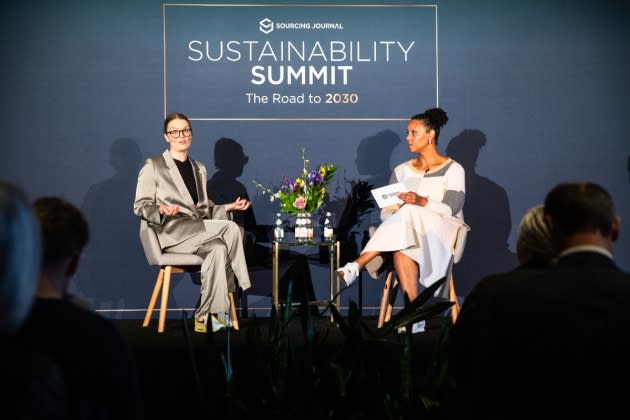H&M Sustainability Lead Says Fashion Must Focus on ‘Circularity Now’

H&M’s North American head of sustainability urged the fashion industry to prioritize progress over promises, and focus on “circularity now.”
At Sourcing Journal’s Sustainability Summit on Tuesday in a conversation moderated by managing editor Jessica Binns, Abigail Kammerzell said the Swedish fast fashion titan has moved on from goal-setting to impact-measuring to bolstering circular progress across its supply chain, to create impacts across the industry at large. “We’re a big one, and we have a lot of responsibility in the industry,” she said. “It’s up to us, with our size and scale, to amplify, accelerate, innovate and support those smaller players.”
More from Sourcing Journal
Quiksilver's New Boardshorts Are Made from its Own Production Scraps
Fabletics and Yitty Want Their Fashion '2 Be Loved' a Little Longer
The company is taking the lead by reinvesting into its global supply chain, helping suppliers optimize their own operations for more sustainable, circular practices. The company’s green investment arm invested 200 million euros ($219.3 million) into initiatives like transitioning suppliers from coal to renewable energy, including installing solar panels. Many are already producing their own energy, “but how do you transition to renewables throughout the entire supply chain?” she said. H&M launched 17 projects over the past year that target eliminating 180,000 tons of CO2 emissions from global apparel manufacturing. “50,000 [tons] are H&M operations, and the rest of it is the broader fashion industry,” she said. “We all work in the same factories and facilities.”
“It’s really about working one-on-one with the factories, working with labor organizations, working with NGOs, and also providing that path to make it easy for suppliers to opt into sustainability similar how you have to make it easy for your customers to opt into sustainable choices,” Kammerzell said
The company has long promoted innovation. H&M’s Co:Lab invests in upstarts focused on areas including fabric recycling, helping them to work through concepts and scale their businesses. Kammerzell cited Los Angeles polyester recycling startup Ambercycle as an example. It partnered with H&M in 2021 on a Circular Design Story collection that featured recycled polyester derived from post-consumer apparel. H&M is seeking to “find the right players and partners” and help them unlock their innovations “for everyone.”
“We’re very early—often first—to try new technologies and new ways of looking at things,” Kammerzell added.
Furthering its circular ambitions, H&M recently launched a partnership with ThredUp through its Resale as a Service (RaaS) platform. The resale marketplace “has an amazing business model” for enabling brand-owned secondhand selling. “The whole vision behind it is that you actually navigate to our Pre-Loved page from the H&M retail site,” Kammerzell said. “Our mission is for current shoppers at H&M to now mix in secondhand with their wardrobes, and that’s a very different business model and a different point of view than a lot of brands have had in the past.” Kammerzell said H&M views resale as a way to increase brand value, and help consumers access even more product.
H&M’s ongoing textile recycling efforts include a project with HKRITA dubbed the Green Machine. Launched in 2016, the project focused on creating a scalable solution for textile waste that would chemically recycle fibers for use in new yarns and garments. Their first industrial chemical textile recycling machine prototype debuted in 2018, and machines have since been installed in Indonesia, Cambodia and Turkey.
Now, H&M is tackling the issue of textile collection and sortation through a joint venture with recycling company Remondis. In February, the partners announced the formation of Looper Textile Co., which aims to extend the use of about 40 million garments this year alone. Garments are reclaimed through H&M’s in-store take-back program, and through Europe’s municipal collection programs. H&M hopes to become more directly involved in the infrastructure for circularity, it said in February. “We are providing the feedstock for recyclers for used clothing,” Kammerzell said Tuesday. The recently launched platform will add to the retailer’s portfolio of solutions, further helping it give its products “a second life.”
When asked what keeps her up at night, Kammerzell referenced the need for scalability and speed in developing and implementing circular solutions. “All of us need to have the ambition and desire,” she said. “I don’t want us to get fatigued. I don’t want us to get distracted.”
